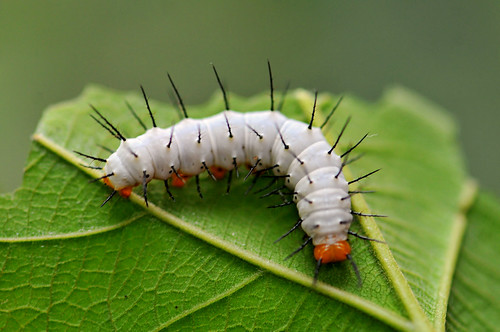The first stage of a butterflies life cycle is the egg. Where it is born into a beautiful creature. It has lots of stages to go to be a full grown adult butterfly. Yes, butterflys breed just like other creatures. Female butterflies lay many eggs at one time, about 100-300 eggs at one time in a female butterflies life or per hatch.
 The caterpillar stage is the second stage in the butterfly life cycle. Its growth is rapid. It feeds off the leaf of the host plant where its hatched. It grows and sheds its exoskeleton and after 4 to 6 molts transforms to the pupa.
The caterpillar stage is the second stage in the butterfly life cycle. Its growth is rapid. It feeds off the leaf of the host plant where its hatched. It grows and sheds its exoskeleton and after 4 to 6 molts transforms to the pupa.
The pupa is the third stage in the butterfly life cycle. This covers the caterpillar. This is called a chrysalis (cocoon). It does not eat in this sage. It can stay in the pupa for a few days to a couple months.
The butterfly is the last stage in the butterfly life cycle. It is in this stage 10-15 days after the cocoon. Before it can fly it unfolds and dries its wings. It feeds on nectar in sweet flowers. Adults mate during this stage and the female lays her eggs on an appropriate plant she thinks would be a safe place.
- Lauren, Jade, Andrea
 The caterpillar stage is the second stage in the butterfly life cycle. Its growth is rapid. It feeds off the leaf of the host plant where its hatched. It grows and sheds its exoskeleton and after 4 to 6 molts transforms to the pupa.
The caterpillar stage is the second stage in the butterfly life cycle. Its growth is rapid. It feeds off the leaf of the host plant where its hatched. It grows and sheds its exoskeleton and after 4 to 6 molts transforms to the pupa. The pupa is the third stage in the butterfly life cycle. This covers the caterpillar. This is called a chrysalis (cocoon). It does not eat in this sage. It can stay in the pupa for a few days to a couple months.
The butterfly is the last stage in the butterfly life cycle. It is in this stage 10-15 days after the cocoon. Before it can fly it unfolds and dries its wings. It feeds on nectar in sweet flowers. Adults mate during this stage and the female lays her eggs on an appropriate plant she thinks would be a safe place.
- Lauren, Jade, Andrea









